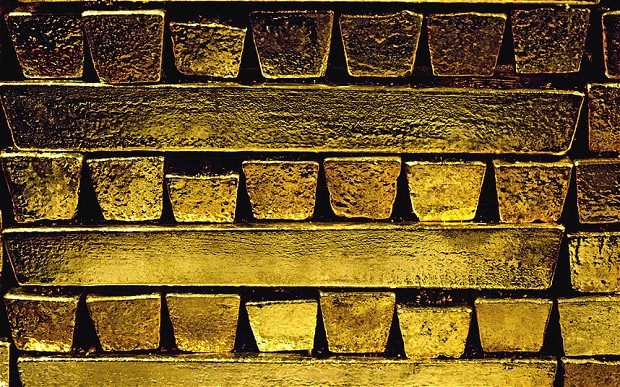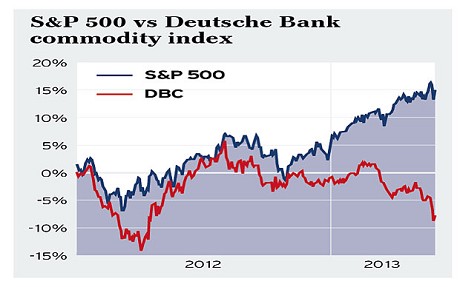Compare Ambrose Evans-Pritchard’s article to …
– Former Assistant Secretary of the Treasury Dr. Paul Craig Roberts: The Assault On Gold – Assault On Gold UPDATE
– Fed and Bank of Japan caused gold crash (Telegraph, Ambrose Evans-Pritchard April 17, 2013):
Commodity prices have been falling since September, culminating in a rout over the past two weeks. That is a classic warning for the global economy.
It is becoming ever clearer that the roaring boom in global equities since last summer has priced in an economic recovery that does not in fact exist. The International Monetary Fund has had to nurse down its global growth forecasts yet again. We are still stuck in an old-fashioned trade depression, with pervasive over-capacity in manufacturing plant and a record global savings rate of 25pc of GDP.
German car sales fell 17pc in March. That should puncture the last illusions that Germany is about to pull Europe out of a self-inflicted slump.
As you can see from the chart below, the divergence between stock markets and the Deutsche Bank index of raw materials is astonishing to behold, so like the pattern in early 1929.
Steel has fallen 31pc this year. Brent crude is off 17pc since early February, and copper 15pc.
You have to be careful reading too much into commodities, distorted by China. The time-honoured cycle is a surge of investment that comes on stream at once with a lag. America’s shale drive has turned the gas market upside down, diverting liquefied natural gas to Europe and Asia. Copper output in Chile rose 7pc last year. The crash in the Baltic Dry Index for shipping rates is partly a tale of too many ships.
Yet excess supply does not explain the collapse in gold over the past week. Cyprus may have been an incidental trigger. If the EU-IMF Troika is determined to strong-arm the Cypriots into selling most of their pint-sized holding of 14 tonnes, it may do the same to Portugal when the time comes, and then you are talking about the world’s 14th biggest holding of 382 tonnes.
Bank of America says the gold crash since Friday has already discounted sales of the entire Cypriot, Portuguese and Greek gold reserves combined. “As we believe additional gold selling in the European periphery is highly unlikely, we find it hard to fully justify the sell-off,” it said.
The central banks of China and the emerging powers bought 535 tonnes last year to escape dollars and euros, the biggest wave of state purchases since 1964. Their strategy is to buy the dips, and they are no fools. The head of China’s reserve manager “SAFE” used to run a US hedge fund.
They won’t try to catch a “falling knife”, prefering to wait until the dust settles. The upward trend of the great bull market has been broken. The technical damage is brutal. Bank of America expects a further drop to $1,200. Be patient.
My view is that the US Federal Reserve and the Bank of Japan “caused” the gold crash. The rest is noise. The Fed assault began in February when it published a paper warning that the longer quantitative easing continues, the harder it will be for the bank to extricate itself.
The report was co-written by former Fed governor Frederic Mishkin, often deemed Ben Bernanke’s “alter ego”. It said the Fed’s capital base could be wiped out “several times” once borrowing costs climb. The window will start shutting by 2014, with trouble then compounding at a “dramatic” pace.
This was a shock. It suggested that the Fed has lost its nerve, and will think long and hard before launching a fresh blitz of money if growth falters.
Then came last week’s Fed Minutes, with hints of tapering off QE earlier that expected. That was the next shock. What they seemed to be saying is that the US economy is groping it way back to normality, that the era of silly money is over, that the dollar will stand tall again.
If that were the case, gold should fall. But it is not the case. The US economy is growing below the Fed’s own “stall speed” indicator. Half a million people fell out of the workforce in March. Retail sales fell in March. So did manufacturing.
The US faces fiscal tightening of 2.5pc of GDP this year, the most since 1946. Ex-labour secretary Robert Reich said the effects have been disguised so far, but a “stealth sequester” is just starting: $51m of grant cuts to Brandeis university; $1m for schools in Syracuse; and so on, the reverse of the stealth stimulus before.
My guess is that the Fed will be forced to row back smartly from its exit talk, but first we must look deflation in the eyes.
As for the Bank of Japan, it had been assumed that the colossal monetary stimulus of Haruhiko Kuroda would revive the yen-carry trade, leaking $1 trillion into world asset markets. But the early evidence is the opposite. Japanese investors brought money home last week.
“Mrs Watanabe” is selling her Kiwi and Aussie bonds to bet on stocks and property at home. And she is selling gold like never before. That too is a shock.
Japan’s “Abenomics” may prove a net drag on the world over coming months. It is exporting deflation through trade effects. This already visible in Korea and China, where soaring wages have eroded competitiveness. “Investors may have forgotten that yen weakness was one of the immediate causes of the 1997 Asian currency crisis and Asia’s subsequent economic collapse,” said Albert Edwards from Societe Generale.
China’s growth rate fell to 7.7pc in the first quarter. It will fall further, though the catch-up boom in the hinterland cities of Chengdu, Chonquing, Changsa and Xi’an may have further to run.
Fitch Ratings says credit has surged from €9 trillion to €23 trillion over the past four years, a rise equal to the entire US banking system. Beijing pumped up loans yet again after its recession scare in the summer, but is gaining less traction. The GDP growth effect of credit has halved. It is the classic sign of an economy sated on debt. China too will have to deleverage.
The world is still in a contained depression. Sliding commodities tell us global money is if anything too tight. “There is a threat of deflation almost everywhere. A lot of central banks will have to follow the Bank of Japan, whatever they say now,” said Lars Christensen form Danske Bank
The era of money printing is young yet. Gold will have its day again.

